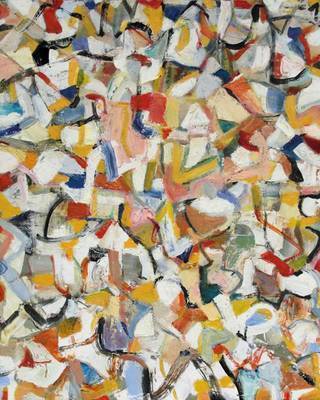George Tun Sein
dal 6/7/2011 al 29/8/2011
Segnalato da
6/7/2011
George Tun Sein
Tally Beck Contemporary, New York
Parallel with Nature. Tun Sein's visual harmonies, 'parallel with nature,' thus subdue or excite the beholder in keeping with their origination in variable kinds of visual phenomena.

The renowned Post-Impressionist, Paul Cézanne, once evocatively stated, 'Art is a harmony parallel with nature.' While Cézanne himself remained 'true to the motif,' or concerned with representational accuracy, the larger implication of his historic whisper was that art might be, above all else, an abstraction, indeed something standing decidedly apart from every political, social, or even moral justification.
Within a few years of Cézanne's passing, the Russian modernist Wassily Kandinsky argued for the 'spiritual' efficacy of color, line, gesture, and composition (Concerning the Spiritual in Art, 1911). Art had finally acquired its own select purpose, that aspiring to a complete 'harmony parallel with nature,' never again to be held accountable for mirroring reality with quotidian precision.
In keeping with such precedents, George Tun Sein suggests that his overriding ambition is to paint 'compositions of quality,' and what is this phenomenon of 'quality' if not the coaxing of an oblique, inexplicable, or poetic resonance from the picture-not unlike the resonance of lived experience found in a musical composition? Born in Burma, but educated as a painter on Western modernism as represented in the world's great museums, George Tun Sein possesses two kinds of cognitive equipoise. One is a power of observation widely striven for in Buddhist monasteries; another is an indefatigable capacity for visual dilation, that tendency for the eye to seek its full, excited saturation by a specific locale's light, shadow, and endlessly episodic architectures.
Tun Sein's visual harmonies, 'parallel with nature,' thus subdue or excite the beholder in keeping with their origination in variable kinds of visual phenomena. The episodic and ephemeral flickers of light against variously painted surfaces of the city; the random shadow of a particular time of day cast across a particular material form in a randomly traversed landscape-these chance, optical epiphanies suggest that light, color, line, gesture, geometric structure-compositions of quality-add up to their own kind of visual (if not quasi-spiritual) pleasure.
Drawing on a rich abstract heritage from late nineteenth-century Expressionism through the New York School, George Tun Sein occasionally cites Willem de Kooning and Clyfford Still, among others, as formidable early influences. Such references are instructive; however, 'compositions of quality' are ultimately not a matter of artistic influences, but a product of an artist's transcendence of the example of every alleged mentor in order to arrive at something true to his own sensuous and ephemeral 'take' on reality. George Tun Sein succeeds at that task masterfully; at the same time, he reminds us of our own such countless, abstract epiphanies, those moments of visual harmony perceived in full saturation of the retina, their finally proving so inexplicably 'parallel with nature.'
- Gregory Galligan
Gregory Galligan Ph.D., is an independent curator, art critic, and art historian. Based in New York since the mid 1980s, he has written extensively for numerous publications and currently contributes regularly to Art in America and ArtAsiaPacific. Recently named a Fulbright Senior Research Fellow to Thailand, Galligan is currently Advisory and Founding Director of the Thai Art Archives, an independent, collections-based archives of Thai modern and contemporary art in Bangkok.
Opening Reception July 7, 2011 from 6 to 9pm
Tally Beck Contemporary
42 Rivington Street, New York



